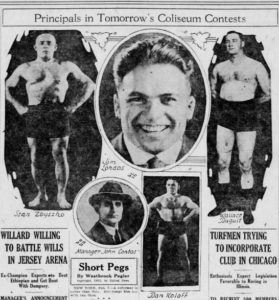Hloov Tastes
Nyob rau hauv kaum ib hlis 1923, St. Louis Star-zaug reporter Billy Murphy peb St. Louis wrestling promoter John Contos. Murphy npaj siab rau Contos cov era ntawm hom wrestlers William Muldoon zoo ib yam li ntawd. Murphy rau ntais ntawv tsis ntev los no ntawm “Ntiaj teb tau zus ib” Hardneck Phillips thiab cov contender mas Webster O'Malley.
Phillips ntse defended nws championship los ntuav O'Malley tom qab 1 teev, 50 feeb. Tej zaum yuav muaj feem ntau “ua haujlwm” Match tshuav ob tug txiv neej utterly sab sab lim.

Ntawv xov xwm tsab xov xwm txog John Contos’ St. Louis Wrestling Card hauv 1923 (Public sau)
Kuv doubts txog cov validity ntawm ntais ntawv tau tsa ceg vim Contos defended ntev bouts thov cov wrestling tuaj saib qhov yuam kev ntev. Contos teev tias kiv cua xav pom ntau yam tuas thiab predicaments lawm ntev qhov yuam kev. Contos argued tias ib match kawg tsuas yog ib los yog ob feeb yuav tau boring.
Contos yuav tsum tau tsa ceg qhov muag brows nrog nws sib piv ntawm kev wrestling rau lub Ziegfield Follies thiab lwm theem qhia tau hais tias. Txawm tias nws tau thov kiv cua xav “ncaj ncees contests”, Nws nquag piv wrestling rau theem qhia tau hais tias. Contos xaiv ib khib analogy xaiv tias accusations ntawm tas qhov yuam kev lawm txij thaum lub 1800s. Ob peb journalists xa mus rau lub wrestlers li kuj mastodons, Li ntawd, nws yog khib rau ib tug neeg nyob rau hauv kev wrestling ua no sib piv. contos’ Lus kuj illustrate li cas tastes hloov thoob plaws hauv lub xyoo.
Kev wrestling evolved rau hauv feem ntau, yog hais tias tsis exclusively, “ua haujlwm” (prearranged) exhibitions rau peb thawj yam. Thawj yog tseeb bouts ris ib sij hawm ntau dua uas raug mob, Li ntawd, wrestlers pib ua hauj lwm nrog sib muab tso rau qhov yuam kev zoo tsis ua rau sib. Tus cooperating wrestlers yuav phua lub payoff ntawm ob leeg xwb khiav tag nrho.
Thib ob, promoters gained tswj championships, Thiab mus saib tau loj nyob rooj vag los muaj lub championship defended, tswj lub sij hawm ntawm qhov yuam kev. “Ob npaug crosses” Tshwm sim thaum ib promoter xa ib yam ntawm nws “shooters” Coj ib championship dua li yav dhau los agreements nrog lwm promoters. Nws risked lwm promoter ire vim tswj lub championship yuav tau lucrative rau nws tus kheej wrestling card thiab los ntawm luam tawm cov tau zus ib rau lwm promoters.
Yog ib qhov tsawg tham txog vim li cas tab sis tus kub siab ntawm tsab xov xwm no yog tias “tua” los yog tseeb wrestling qhov yuam kev yuav yog ob leeg ntev thiab boring. William Muldoon, Leej twg txawb ib tug xov tooj ntawm wrestlers feeb li Murphy taw tes qhia tawm hauv pib ntawm nws tsab xov xwm, wrestled ib xya teev kos nrog Clarence Whistler. Kuv xav ntau npaum li cas kiv cua muaj kawg ntawm ntawd match?
Ed “Strangler” Lewis thiab Joe Stecher wrestled ob-teev draws uas tau hais tias yuav tsum tau “tua” ntais ntawv. Qhov teeb meem biggest nrog ib tug “tua” Yog ob equally matched wrestlers xws li Lewis thiab Stecher yuav khi rau teev nrhiav ib tug coj los yog tuav. Wrestlers tua ua ke nyob rau hauv dab tshos thiab luj tshib khi rau teev nrhiav ib tug tuav yuav ua exciting li menyuam lub tsheb rust.
Yos Xes “Toots” Mondt, Lewis’ tus khub thiab ib promotional genius, Pib ntxiv nyob rau hauv concepts xws li hais mav zoo thiab hais mav phem thiab luv luv qhov yuam kev uas muaj ntau ntog hauv ib teev kom wrestling exciting ntxiv exciting.
Thaum lub 1930s, wrestling qhov yuam kev tsis tshua mus dua ib teev. Thaum cov ntais ntawv puas tau mus ntev, Nws yog nquag cov lus xaus ntawm ib feud thiab yuav lub xeem match rau daim card ntawm ob biggest hnub qub.
Dua li ntawm Contos ntseeg tias luv luv qhov yuam kev tsis tau entertaining heev, Lub 1980s nkag tau ntau luv luv qhov yuam kev xws li 2 mus 3 Feeb qhov yuam kev txawm ntawm zoo regarded wrestlers. Yog hais tias koj saib ib lub 20-feeb acrobatic nrug hnub no, Uas kis tau rau kev wrestling, Koj yuav ceev nrooj pom vim li cas luv luv qhov yuam kev yuav tsum tau lub sij hawm.
Ob peb xyoos tom ntej no, Qhov yuam kev tej zaum yuav tau luv luv rau ib pliag, tiam sis qhov sib yuav rov qab mus ntev qhov yuam kev. ntev mus ntev tuaj, Tiam sis rov qab mus thiab forth li wrestlers adapt rau lawv audiences. 17,000 Kiv cua tuaj saib Phillips swb O'Malley, Li ntawd, Contos yuav tsum paub tias nws cov neeg tuaj saib thaum lub sij hawm.
Koj yuav tawm ib saib los nug cov lus nug txog qhov no los yog tej tsev xa rau kuv Facebook phab.
Tau qhov twg los: St. Louis Star-zaug, Kaum ib hlis 5, 1923 ib tsab, p. 15
Pin It
